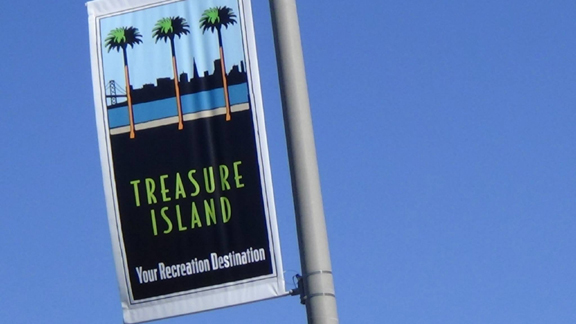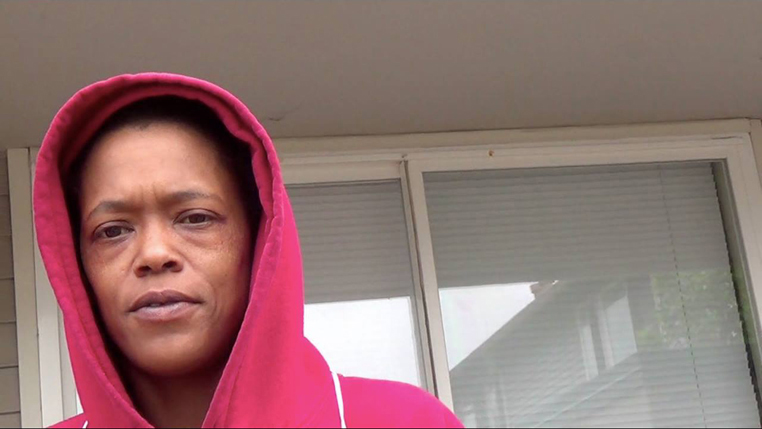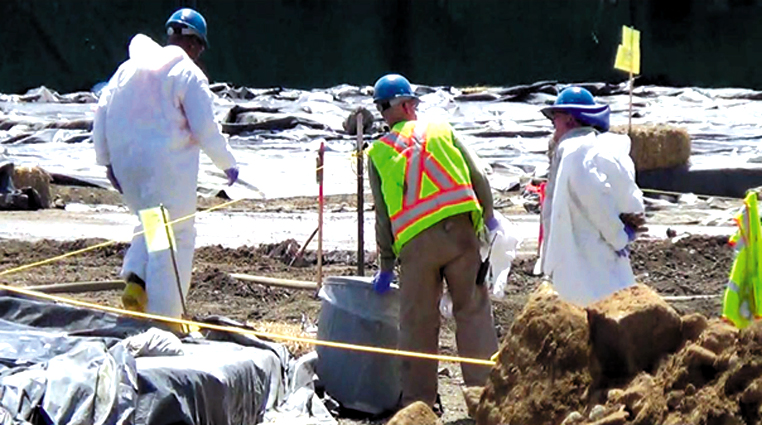
by Carol Harvey
Is the radiation on Treasure Island making Jim Serrano ill? Serrano describes the illnesses he has developed since moving onto an area on the former Naval Station Treasure Island that is contaminated by chemicals and radioactive materials: Polycythemia, a form of leukemia, unidentified liver disease and constant pain.
Ghost Ship
Think of manmade Treasure Island as an iridescent green ghost ship whose prow divides the blue waves as it navigates San Francisco Bay waters gliding northwest under the Golden Gate Bridge.
Standing on your tidy, low- or no-income front lawn on the island’s northwestern wedge, it is as if you are steering the bow of the radioactive vessel as it bears its toxic contents ever forward into a stunning red-gold sunset.
Imagine the vessel sliding toward Japan carrying the U.S. Navy’s gift of radiation mixing with radioactive water from the Fukushima Daiichi Nuclear Plant, detectable along the California Coast in spring 2014.
On a recent warm fall night, I strolled to the Berkeley side of Site 12, the Navy’s designation for one of its radiological and chemical cleanup areas. I plopped down in a chair in the Fat Grape Winery next to a sign reading, “Group therapy practiced here,” and, over a glass of cabernet sauvignon, shot the breeze with vintner Patrick Bowen.
I kidded Bowen about placing Fat Grape signs everywhere. “How else can you find me?” he laughed. “I’m stuck in the back inside the old Navy Brig.”
Bowen is one of 160 business owners who are as friendly as his Site 12 neighbors. Later, when I lost my way to Gateview Avenue to catch the MUNI 108 bus, an African-American elder with a kind of awesome gentility noticed my confusion and offered directions. It’s a tiny village. Everyone knows everyone. Site 12 people are friendly to neighbors and strangers. It’s remarkable how they care for and love each other.
Toxic Island
Fifty years of Naval activity, however, have contaminated Site 12 with a horrifying array of pollutants, including radioactive materials and chemicals.
Breathing, touching or ingesting radioactive substances produces ionizing radiation that can break apart and re-bond with atoms in your body. These processes can continue for years, deforming your tissue and causing cancer.
Lethal levels of three additional toxins — asbestos, lead and mold — lurk in the roofs, exterior paint and interior walls of houses and buildings on Site 12.
Asbestos, Mold—and Asthma
After the U.S. Navy abandoned the island that they used for an ammunition bunker and storage yard, their dilapidated structures still sit along island streets, silently inviting children to play inside and homeless people to seek refuge.
Current residents inhabit old Navy family housing units. In the walls, asbestos insulation quickly becomes saturated with dangerous molds which grow unchecked in surrounding soil and groundwater, producing rampant respiratory disease. According to San Francisco Fire Department officials, asthma is an island epidemic.
On March 7, 2014, San Francisco Fire Department Assistant Deputy Chief Ken Lombardi announced the evacuation of firefighters from Station House 48, located at 849 Avenue D at 10th Street, to the fire training facility at 600 Avenue M.
The firefighters’ union complained that rain through leaky windows created dangerous levels of toxic mold in the station’s interior walls. Men were getting headaches and waking at night. Asthma, chronic congestion and respiratory diseases are widely reported among nearby townhouse residents.
Lead-based Paint
Lead-based paint visibly chips off the exterior walls of abandoned Navy buildings — structures built in the 1940s and ‘50s, roughly 30 years before 1978 when the U.S. government banned lead paint.
Teens play in the yard next to a tuition-free charter high school, the Life Learning Academy, at 651 Eighth Street, immediately west of a long row of buildings on Avenue M covered with old, badly flaking paint fragments blowing around in the island’s high winds.
Exposure to lead’s heavy metal component could damage these teens’ nervous systems and kill their brain cells.
There are suspicions that lead or heavy metals leaching into drinking water from aging pipes could have caused a recent rash of gall-bladder removals.
Before the island can be redeveloped, the U.S. Navy is required, under the Federal Installation Restoration Program, to locate and remediate from the island radioactive and chemical contaminants, asbestos, lead and mold. The work is scheduled for completion by 2018.
Neither the Navy, nor the Treasure Island Development Authority (TIDA), a mysteriously formed State and City corporation running the island while it buys it back from the Navy, have announced they will clean up asbestos, lead and mold, which, like radiation and chemicals, pose a serious public health risk to everyone living and working there.
The Navy has deferred cleanup to TIDA who has kicked it downstairs to the Treasure Island Homeless Development Initiative (TIHDI), which, in turn, is making no visible attempt at remediation.
Trapped On Treasure Island
These sweet people, bombarded from every direction by radionuclides, chemicals, asbestos, lead and mold contaminants, appear to be placeholders on extremely valuable property until Lennar, the corporate builder, can redevelop the island, populating high-end condos with 18,000 new renters in gleaming towers perched precariously on liquefaction-prone soil.
TIDA and TIHDI seem to be warehousing the Site 12 community of savagely poor people in an aging, neglected infrastructure left to ruin. During the years from 1999 to 2014, un-remediated radiation, chemicals and asbestos, lead, and mold in homes constructed from the 1950s to the 1980s have made occupants sick.
Former San Francisco Mayor Willie Brown, who formed TIDA, seems to have deliberately omitted from its regulations the 14 Just Cause tenant protections enjoyed by San Francisco residents. Islanders fear eviction without notice.
As they sicken and die, their low incomes trap — and intimidation paralyzes — 2,000 poor people. Complaints about 70-year-old water pipes or black mold in bathrooms could produce retaliatory evictions by subsidized housing agencies at Catholic Charities, Community Housing Partnership, San Francisco Housing Authority, or John Stewart Company, the market-rate rent king.
TIDA officials say that, after the Navy’s cleanup, redevelopment will turn Treasure Island into an eco-village. Are its dilapidated, falling-down buildings and broken infrastructure currently being neglected because those in charge expect it will all be plowed under?
Potentates’ political pawns
Are Site 12 residents the pawns in a political game officiated over by power-brokers so high in the stratosphere that you and I never see them?
A nest of incestuously connected wealth, including Nancy Pelosi, Willie Brown, Gavin Newsom and Dianne Feinstein, will make megabucks after redevelopment, not to mention Mayor Ed Lee, who finally did the deal for an environmentally clean, pristine, high-end, Treasure Island eco-village.
Interests connected to TIDA have already raked in millions from market rate and subsided rents, but could ultimately make billions.
Institutional classism
The Base Closure Community Redevelopment and Homeless Assistance Act of 1994 requires the use of Naval base resources to assist homeless persons.
TIDA’s public relations brainchild, the Treasure Island Homeless Development Initiative (TIHDI, pronounced”tie-die”), an umbrella organization for nonprofits, offers compassionate services such as subsidized housing, job placement and a food bank to low-income, pre-homeless, homeless, disabled and “recovering” San Franciscans.
A classist, condescension-tinged message traced in wet cement outside TIHDI’s Ship Shape Community Center, which hosts a weekly food pantry at 850 Avenue I, orders supplicants to stand behind a line and “Wait here until called.”
Under TIDHI, Swords to Plowshares offers transitional housing to veterans. One reported he knew about the radioactivity because, he said, “The water tastes nasty.”
There is a fine irony in the Navy’s offering a vet, recovering from failure to medicate war-induced trauma with drugs, a recovery place saturated with opportunities for radiation sickness, chemical poisoning, asbestosis or black-mold-induced respiratory illness.
Toolworks’ attractive webpage offers prospective employers a disability “workforce.” Community members, however, report working low-level jobs involving little skill-building or training.
Walter Johnson, for example, is an enterprising, busy man. After prison, he used TIDHI’s services to spring himself from a homeless shelter to free housing to paying rent. Now he scours the island for trash with a shopping cart, works odd jobs, and helps the Haight Ashbury Free Clinics distribute food.

Three Toxic Sub-Sites
Embedded within Site 12’s 93-acre body like tumors lie three major sub-sites, Halyburton Court, Site 31 and Site 6.
Situated at Treasure Island’s northwestern end, Halyburton Court hosts phantom children trapped forever in silent trauma. A father of a 1970s military family shuddered recalling the innocent play of children as their bodies were bombarded by radioisotopes along the shoreline near the mockup ship USS Pandemonium One from which sailors were trained to flush radioactive material.
Halyburton Court is so toxic that after the Navy decommissioned the island in 1997, they cordoned it off. In 1999, when at-risk homeless and low-income San Franciscans moved onto Site 12, they were never allowed to live in Halyburton Court.
Sub-site 31
Just inland, eastward from Halyburton Court, kids from the nearby elementary school and Boys and Girls Club played and ran track on an asphalt area on Sub-site 31. Around 2005, this lighthearted exercise stopped.
The Navy fenced off the space, dug a 10-feet-by-40-feet-deep pit at its southeastern end and removed truckloads of toxic material. Residents reported that uncovered chemically contaminated dust blew across Site 12 into Gateview Avenue and 11th, 12th and 13th street neighborhoods.
Ocean winds gusting northwest to southeast off the Bay across Halyburton Court and Site 31 toward the San Francisco Bay Bridge span seem to have created a poisoned wind-lane flanked by dead trees and vegetation near the former elementary school, the vacated Boys and Girls Club and a currently operating daycare center.
Sub-Site 6
Until late summer 2014, when it was moved nearby to the shore, Sub-site 6 lurked just inland behind a chain link fence across Avenue M from the island’s wastewater treatment plant. From Sub-site 6, the Navy continually moved a conveyor-belt-like trail of thousands of boxcar storage containers full of radiologically toxic materials recovered from island remediation sites.
Navy personnel verified that these containers are shipped off-island to a Utah nuclear dumpsite.
Site 6 is also the historically significant locus of a 1950s fire training school, where toxic oil-based materials that firefighting trainees employed to snuff out blazes were casually dumped in its soil.
Additionally, in 1969, the Navy moved USS Pandemonium One, its mock-up, nuclear war training ship, eastward to the shore opposite Berkeley where she became Pandemonium Two. Next to the seismically unsafe water treatment plant built in the 1950s, her radioactive discharges potentially poisoned a second Site 12 sector, especially dangerous since earthquake or water rise could flood the area with raw sewage — bad — and radioisotopes and chemical contaminants — infinitely worse.
Little List of Horrors
The Navy is responsible for cleaning up the list below of radioactive and chemical contaminants from soil and groundwater under and within Site 12 homes.
Radium 226: Painted on glow-in-the-dark “buttons” buried in Treasure Island soil for naval trainees to hunt with geiger counters, radium 226 is a highly unstable radioactive element which decays into the inert gas, radon. Collected in lung tissue, radon causes cancer.
Cesium 137: In 1950, dangerous cesium 137, a byproduct of nuclear fission, was accidentally spilled in a Navy training school, Building 233. A shorter half-life of 30 years makes Cesium 137 a stronger emitter, throwing off radioactive atoms faster. Yet it is persistent in the environment and works its way up the food chain.
‘Dirty Dozen Chemicals’
At the 2001 Stockholm convention, an international treaty banned production, import, export, disposal and use of “the dirty dozen” chemicals the United Nations considers the world’s most dangerous. Of these 12 banned chemicals — aldrin, chlordane, DDT, dieldrin, endrin, heptachlor, mirex, toxaphene, polychlorinated biphenols (PCBs), hexachlorobenzene, dioxins and furans — the eight chemicals described below persist in island soil, water, air and structures.
- DDT
Inhaling DDT leads to long-term kidney and liver disease, cancer and death.
- PCBs
PCBs, Polychlorinated Biphenyls: While Naval remediators say they are cleaning up Site 12’s PCBs, every day Jim Serrano’s family lives with his painful liver disease. EPA studies found PCBs suspect for liver and skin cancer. In 1979, Congress banned their use as transformer, capacitor and electric motor coolants.
- Benzene
Benzene, a carcinogenic constituent of crude oil and gas, is a widely used petrochemical solvent. My father would not have cleaned his suits with a benzene-based spot remover, Renuzit, had he known it caused leukemia. In an orgy of industrial burning, the Navy sent oil-generated benzene fumes boiling skyward from Site 12 burn pits and incinerators where homes now stand.
Benzene remains in dirt as soot, continuing to emit fumes as high island water levels dissolve dry benzene soot in wet soil. Benzene weakens the immune system, causing leukemia, aplastic anemia and breast cancer. Inhaling vapors damages reproductive organs and produces infertility. Islanders report premature reproductive organ growth, ovarian cysts, miscarriages and hysterectomies.
- PAHs
PAHs, or Polycyclic Aromatic Hydrocarbons: Through the 1970s, PAH-laden smoke wafted above island homes as sailors set fire to materials in burn pits and incinerators. PAHs consist of hundreds of carcinogens, products of incomplete burning of coal, gas and garbage released as soot or attached to airborne particulate matter, settling in soil or groundwater. Touching or breathing PAHs causes skin, stomach and lung cancer.
- Dioxin
Dioxins, polychlorinated dibenzodioxins, include a class of 75 chemically stable, organic, proven carcinogens, produced when the Navy burned chlorinated plastic medical waste: IV bags, gloves, oxygen tents. A burn pit was discovered on Bayside Drive near a family of three females with newly-diagnosed cancer.
The chemically stable, organic pollutants in dioxin store persistently and permanently in the food chain and in children’s fatty tissue, especially females. As their bodies convert it to growth material — bone, muscles, tissue, brain — dioxin is passed into offspring.
Dioxin is suspect in liver, lung, stomach, soft tissue and connective tissue cancers, non-Hodgkin’s lymphoma and the weakening of the immune system. This hormone disruptor produces genetic defects, reproductive and developmental problems.
- Arsenic
Arsenic is found in herbicides and pesticides. Made notorious by director Frank Capra in the black comedy, “Arsenic and Old Lace,” arsenic is mixed by two old ladies into elderberry wine to perpetrate mercy killings on lonely old men. Unmerciful symptoms include stomach pain, diarrhea, vomiting, vertigo, delirium, shock and death.
- TPH
TPH, Total Petroleum Hydrocarbons: If you swallow fossil fuels, petroleum distillates and natural gas in high concentrations, you’ll vomit. If you inhale them, your body will bloat. When burned at the Site 6 former fire training station, TPHs caused soot to form in soil. With the raising and lowering of the island’s tides, TPH soot persists in groundwater and air.
- VOCs
VOCs, Volatile Organic Compounds: Open burning exposed islanders to harmful VOCs causing respiratory and heart problems, eye, nose and throat irritation, headache, poor coordination, nausea, and central nervous system, liver and kidney damage.
Bullets from all directions
A legal victory would be difficult with so many environmental toxins at play. It’s hard to draw a straight line between disease and cause. But, anyone living in Site 12 over a year who escapes illness could make a killing in Reno. With bullets flying in all directions, someone is bound to get hit.
